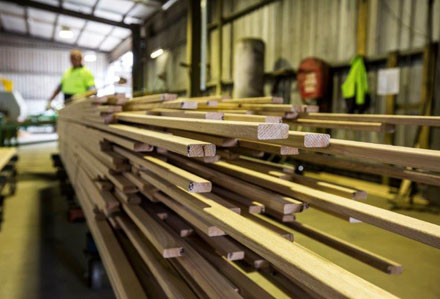
Many native forest timber mills in Victoria remain fearful of the future despite the extension of the regional forest agreements (RFAs) until 2020. Source: Timberbiz Philip Hopkins
Six sawmills, reeling since their timber supply contracts have not been extended by VicForests, have called on the Andrew Government to honour their timber supply contracts.
A spokesman said since last year’s $60-million plus government bailout of the Heyfield mill, the Victorian timber industry had been operating “in a sea of confusion and uncertainty”. This put their businesses at risk and potentially threatened thousands of jobs and regional communities, he said.
The G6 are Fennings Timbers (Bairnsdale), Ryan & McNulty (Benalla), Dindi Sawmill (Murrindindi), AG Brown Sawmill (Noojee and Drouin West), Kelly’s timber (Westburn) and Powelltown Sawmills.
The RFAs for Central Highlands, East Gippsland and the North East were this week extended by the state and federal governments for two years to bring them into line with the other Victorian RFAs, West Victoria and Gippsland. All five are effective until 31 March 2020.
The Assistant Minister for Agriculture, Anne Ruston, said this would allow the Australian and Victorian Governments to deliver the long-term extension to all five RFAs as one package. RFAs last 20 years and are reviewed every five years.
The peak state and federal timber associations cautiously welcomed the RFAs extension, but said more needed to be done to secure a long-term future for the thousands whose jobs depended on a secure resource supply.
A spokesman for the G6, Brian Donchi, said a major concern for millers and contractors was that VicForests was not tendering contracts for wood supply beyond 2021.
“We need the same certainty that was given to Heyfield. We just want to know whether we should be worried or not,” said Mr Donchi, resource manager at Fennings. “Without certainty of supply we have nowhere to go.”
Mr Donchi said the Victorian Government had a conflict of interest as a major shareholder in a private company (Heyfield mill).
“As an owner of this mill, it is a competitor with every other timber mill in Victoria,” he said.
Currently, about 450,000 hectares, or 5.7% of Victoria’s native forest, is available for harvest. In 2016-17, VicForests, the Government’s forestry arm, harvested 2965 hectares or 0.038 per cent of the total native forest area.
The Central Highlands RFA is particularly complex because the area includes the habitat of the Leadbeater’s Possum, which is officially classed as “critically endangered”.
Comprehensive surveys over the past four years have found more than 200 new possum colonies, and the Federal Government is re-assessing the possum’s critically endangered status. An answer is expected towards the end of the year.
Timber harvest exclusion zones (THEZ) of 200-metre radius of each detection site have been put in place, cutting back the timber available and costing the Gippsland timber industry millions of dollars.
A State Government review of the surveys proposed a radical shift to protect the possum, arguing that changing to landscape planning would be a better management tool than the current THEZs. The report was prepared by the Department of Environment (DWELP).
“A landscape scale approach that moves away from the use of detection-based prescriptions will also provide greater certainty and reduced costs to industry,” the report says.
The report also recommended reviewing THEZs and other existing Special Protection Zones (SPZ) in the Central Highlands to optimise the availability of timber availability, and protect the LP, threatened species and other forest values. However, in the interim, the 200-metre THEZs should be continued.
After more surveys, the report said the Central Highlands State forest zoning scheme, including the THEZ, should be reviewed. This would take into account new information and changes in the forest since the LP reserve system was set up in 2008.
When the Victorian RFAs were first signed, 955,000 hectares of forest was put into conservation reserves.







